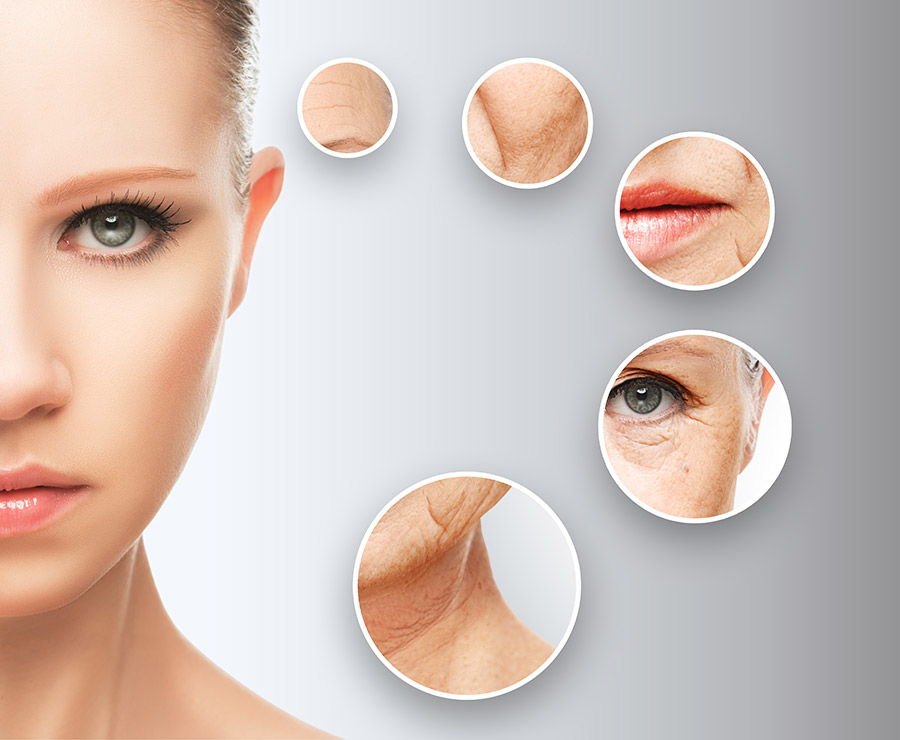You’ve heard of collagen and know that it’s good for your skin. But let’s take a deeper dive with Veronica Wheat, the “V” in Chef V and find out exactly what collagen is and how to boost levels of it in your body so that your skin looks more youthful. And let’s improve our skin in healthy ways.
Have you ever seen a skyscraper under construction? Ever wonder how they build these monstrosities? With scaffolding just like this:

What does scaffolding and skyscrapers have to do with your skin?
Well, in order to understand collagen, you first have to imagine that your skin and bones also have a matrix (obviously on a much smaller scale, like invisible small).
Collagen Basics For Skin
The stretchy connective tissue that makes up your skin requires a strong, structural framework, just like skyscraper scaffolding. The framework that prevents your skin from completely sagging to the floor is called the extracellular matrix.
And there’s something that needs to provide structural integrity to this extracellular matrix. And that something is collagen—the most important protein in connective tissue (skin), not to mention your bones.
Out of thousands of proteins in the human body, collagen is by far the most abundant. Roughly 30% of all protein in the human body is one type of collagen or another.
There are 28 different collagen types, but when it comes to youthful-looking skin, we’re only concerned with collagen type I & III.

How Aging Affects Collagen
The aging process can be cruel to the skin. And what’s going on under the hood of our skin, so to speak, is that by the time you’re 25, your collagen levels in your body are already on the decline.
In fact, starting around age 30, 2% of our collagen stores will be depleted. By age 40, we have lost roughly 15% of the collagen we had when we were born. (But don’t let that depress you if you’re celebrating your 40th soon!). Then, once we turn 60, say goodbye to roughly 50% of your original collagen.
Going through menopause is especially a collagen killer. That’s because when you go through menopause, your estrogen levels plummet. Estrogen is vital for collagen production.
“Estrogen appears to aid in the prevention of skin aging in several ways. [It] prevents a decrease in skin collagen in postmenopausal women; topical and systemic estrogen therapy can increase the skin collagen content and therefore maintain skin thickness.” —The American Journal of Dermatology
How To Defy The Aging Process & Support Collagen Through Food
So there’s good news and bad news with collagen. I’ll start with the bad. While our bodies can make new collagen, as we age, we lose more of it than our body can rebuild and repair. And not only that, the collagen protein fibers that we do have start getting weaker. That’s why wrinkles develop.
The good news is that there are simple nutritional interventions that can help our collagen build back better.
Chicken Bone Broth
I’m not a strict vegetarian but I rarely promote meat. One rare exception is bone broth because it contains collagen. Bone broth contains collagen protein because the process of slow cooking bones for many hours releases collagen from the bones. So by consuming the collagen from animal bones, you’re helping revitalize your own body’s collagen.
In addition, bone broth contains other nutrients that help with collagen growth and repair such as:
Hyaluronic acid
According to the Cleveland Clinic, it helps skin stretch and flex and reduces skin wrinkles and lines; also reduces visible scars.
Chondroitin
This compound plays a major role in connective tissue and is essential for normal skin health and regeneration.
Glycosaminoglycans
Known as GAGs, these complex sugars—not the unhealthy kind you might think of in junk food—hold nearly 1,000 times their own weight. Translation: a moisturizing weapon for your skin you’ve never heard of. GAGs also support collagen and elastin, another important skin structural protein.
In addition, bone broth contains a great balance of minerals that support collagen production. But what if you’re a vegetarian? Thankfully, there are non-meat, collagen-building foods…
Green Leafy Veggies
Nearly everybody knows that green leafy veggies are among the healthiest foods on Earth. (Can’t stand eating them? Then drink them!)
But what you may not know is that green leafy veggies are a great source of a vitamin that hardly gets any attention: vitamin K. And it turns out that vitamin K is really effective at building that skin-and-bone scaffolding matrix I was talking about earlier, research shows.
Citrus Fruits & Berries
Citrus and berries contain good amounts of vitamin C. And vitamin C is a precursor (building block) of collagen. So make sure you’re getting both citrus and berries in your diet everyday.
Collagen Powder
Very few people like sipping on a piping hot mug of bone broth in the summer. And many people don’t like the meaty, savory taste of bone broth everyday. But you can get the benefits of collagen without broth simply by adding a scoop of collagen powder to a smoothie (or even your Green Drink!).
More and more non-meat-sourced collagen powders have become available, including marine collagen powder (derived from fish) and even plant-based collagen powders.
Botox For Collagen
And finally, no article about more youthful skin would be complete without mentioning botox. OK, so you can’t eat botox. That would be bad, and it’s the reason why babies can’t eat honey for the first year of life. (Both botox and honey have a toxin called botulinum.)
Obviously, people can go overboard with the botox treatments. But if you’re in need of major wrinkle reduction, there’s no doubt that Botox helps the skin build collagen. But don’t think that by getting a Botox injection, it gives you a free pass to eat like crap! You need to eat a high antioxidant diet every day otherwise the effects of Botox may be short-lived.
Bottom line, there aren’t enough long term studies on the effects of botox injections. We recommend getting as much collagen as you can in your diet, limiting your exposure to botox and trying a more natural route.
